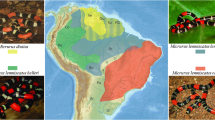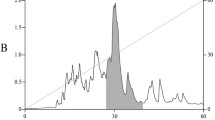Abstract
-
1.
The action of the crude venom of the scorpionButhus tamulus and of three highly purified neurotoxic fractions were studied in voltage-clamp experiments with single nerve fibres of the toadXenopus laevis.
-
2.
Both crude venom and the fractions studied reduced the sodium current and slowed down the inactivation of the sodium permeability.
-
3.
The toxin effects developed mainly in 2 or 3 min (15°C) and were almost irreversible after washing with Ringer solution.
-
4.
With positive pulses an inward- or outward-directed plateau of the sodium current seemed to be reached after a few 100 ms. It was sensitive to TTX. During very long pulses (50 s) a further decay of the current was seen.
-
5.
When a positive pulse to −26 mV inducing a maintained inward current was followed by a positive pulse to −1 mV the inward current increased to a new level.
-
6.
At potentials >−30 mV the steady-state inactivation of the sodium system decreased again.
-
7.
When scorpion toxin was applied in the presence of 100 nmol/l TTX no slowing down of the sodium current occurred, indicating a protecting effect of TTX.
-
8.
50 to 100 mg/l crude venom reduced the peak sodium current by 50%.
-
9.
In a dose-response relation the effect of the toxins was taken as the current after 30 ms related to the peak sodium current. Although fraction V had a molecular weight of only 4400 it exerted no peculiar effects as compared to fractions XII and XIII (MW 7500 and 8000). The half values of the maximal effects of the toxins were at concentrations around 1 μmol/l.
-
10.
It is suggested (I) that a smaller part only of the molecule inherent in all fractions is responsible for the toxic effects and (II) thatButhus tamulus toxins bind to channel proteins in the vicinity of the TTX receptor at the external membrane surface and by an allosteric reaction of channel proteins impede or even immobilize the inactivation mechanism and render it leaky.
Similar content being viewed by others
References
Armstrong CM, Bezanilla F, Rojas E (1973) Destruction of sodium conductance inactivation in squid axons perfused with pronase. J Gen Physiol 62:375–391
Bergman C (1970) Increase of sodium concentration near the inner surface of the nodal membrane. Pflügers Arch 317:287–302
Bernard P, Couraud F, Lissitzki S (1977) Effects of scorpion toxin fromAndroctonus australis venom on action potential of neuroblastoma cells in culture. Biochem Biophys Res Commun 77:782–788
Bernard P, Couraud F (1979) Electrophysiological studies on embryonic heart cells in culture: Scorpion toxin as a tool to reveal latent fast sodium channel. Biochim Biophys Acta 553:154–168
Cahalan MD (1975) Modification of sodium channel gating in frog myelinated nerve fibres byCentruroides sculpturatus scorpion venom. J Physiol (Lond) 244:511–534
Carbone E, Wanke E, Prestipino G, Possani LD, Mälicke A (1982) Selective blockage of voltage-dependent K+ channels by a novel scorpion toxin. Nature 296:90–91
Catterall WA (1979) Neurotoxins as allosteric modifiers of voltage-sensitive sodium channels. In: Ceccarelli B, Clementi F (eds) Advances in cytopharmacology, vol 3. Raven Press, New York, pp 305–316
Catterall WA, Ray R, Morrow CS (1976) Membrane potential dependent binding of scorpion toxin to action potential Na+ ionophore. Proc Natl Acad Sci USA 73:2682–2686
Chandler WK, Meves H (1970) Evidence for two types of sodium conductance in axons perfused with sodium fluoride solution. J Physiol (Lond) 211:653–678
Chhatwal GS, Habermann E (1981) Neurotoxins, protease inhibitors and histamine releasers in the venom of the Indian red scorpion (Buthus tamulus): Isolation and partial characterization. Toxicon 19:807–823
Chiu SY (1977) Inactivation of sodium channels: Second order kinetics in myelinated nerve. J Physiol (Lond) 273:573–596
Conti F, Hille B, Neumcke B, Nonner W, Stämpfli R (1976) Measurement of the conductance of the sodium channel from current fluctuations at the node of Ranvier. J Physiol (Lond) 262:699–727
Dodge FA, Frankenhaeuser B (1958) Membrane currents in isolated frog nerve fibre under voltage clamp conditons. J Physiol (Lond) 143:76–90
Drouin H, Neumcke B (1974) Specific and unspecific charges at the sodium channels of the nerve membrane. Pflügers Arch 351:207–229
Fontecilla-Camps JC, Almassy RJ, Suddath FL, Watt DD, Bugg CE (1980) Three-dimensional structure of a protein from scorpion venom: A new structural class of neurotoxins. Proc Natl Acad Sci USA 77:6496–6500
Frankenhaeuser B (1960) Quantitative description of sodium currents in myelinated nerve fibres ofXenopus laevis. J Physiol (Lond) 151:491–501
Gillespie JI, Meves H (1980) The effect of scorpion venoms on the sodium currents of the squid giant axon. J Physiol (Lond) 308:479–499
Gülden K-M (1980) More than one carboxyl group is essential for the function of Na channels of the nodal membrane. Proc Int U Physiol Sci XIV:454
Haas V de, Siemen D, Vogel W (1982) Partial blockage of the Na inactivation gate by scortion toxins studied with computer support. Pflügers Arch Suppl 392:R32
Hodgkin AL, Huxley AF (1952) A quantitative description of membrane current and its application to conduction and excitation in nerve. J Physiol (Lond) 117:500–544
Kniffki K-D, Siemen D, Vogel W (1981) Development of sodium permeability inactivation in nodal membranes. J Physiol (Lond) 313:37–48
Koppenhöfer E, Schmidt H (1968a) Die Wirkung von Skorpiongift auf die Ionenströme des Ranvierschen Schnürrings: I. Die Permeabilitäten PNa und PK. Pflügers Arch 303:133–149
Koppenhöfer E, Schmidt H (1968b) Die Wirkung von Skorpiongift auf die Ionenströme des Ranvierschen Schnürrings: II. Unvollständige Natrium-Inaktivierung. Pflügers Arch 303:150–161
Meves H, Rubly N, Watt DD (1982) Effect of toxins isolated from the venom of the scorpionCentruroides sculpturatus on the Na currents of the node of Ranvier. Pflügers Arch 393:56–62
Mozhayeva GN, Naumov AP, Soldatov NM, Grishin YV (1979) Effect of the toxins of the scorptionButhus eupeus on the sodium channels of the membrane of the node of Ranvier. Biophysics 24:242–249
Mozhayeva GN, Naumov AP, Nosyreva ED, Grishin EV (1980) Potential-dependent interaction of toxin from venom of the scorpionButhus eupeus with sodium channels in myelinated fibre: Voltage clamp experiments. Biochim Biophys Acta 597:587–602
Narahashi T, Shapiro BI, Deguchi T, Scuka M, Wang CM (1972) Effects of scorpion venom on squid axon membranes. Am J Physiol 222:850–857
Nonner W (1969) A new voltage clamp method for Ranvier nodes. Pflügers Arch 309:176–192
Nonner W (1979) Effects ofLeiurus scorpion venom on the ‘gating’ current in myelinated nerve. In: Ceccarelli B, Clementi F (eds) Advances in cytopharmacology, vol 3. Raven Press, New York, pp 345–352
Okamoto H, Takahashi K, Yamashita N (1977) One-to-one binding of a purified scorpion toxin to Na channels. Nature 266:465–468
Rochat H, Bernard P, Couraud F (1979) Scorpion toxins: Chemistry and mode of action. In: Ceccarelli B, Clementi F (eds) Advances in cytopharmacology, vol 3. Raven Press, New York, pp 325–334
Romey G, Chicheportiche R, Lazdunski M (1975) Scorpion neurotoxin — a presynaptic toxin affects both Na+ and K+ channels in axons. Biochem Biophys Res Commun 64:115–121
Romey G, Abita JP, Schweitz H, Wunderer G, Lazdunski M (1976a) Sea anemone toxin: A tool to study molecular nechanisms of nerve conduction and excitation-secretion coupling. Proc Natl Acad Sci USA 73:4055–4059
Romey G, Abita JP, Chicheportiche R, Rochat H, Lazdunski M (1976b) Scorpion neurotoxin: Mode of action on neuromuscular junctions and synaptosomes. Biochim Biophys Acta 448:607–619
Rudy B (1978) Slow inactivation of the sodium conductance in squid giant axons. Pronase resistance. J Physiol (Lond) 283:1–21
Schmidtmayer J, Stoye-Herzog M, Ulbricht W (1982) Rate of action ofAnemonia sulcata toxin II on sodium channels in myelinated nerve fibres. Pflügers Arch 394:313–319
Schmitt O, Schmidt H (1972) Influence of calcium ions on the ionic currents of nodes of Ranvier trated with scorption venom. Pflügers Arch 333:51–61
Stämpfli R (1974) Intraaxonal iodate inhibits sodium inactivation. Experientia 30:505–508
Siemen D, Vogel W (1982) Effects ofButhus tamulus toxins on sodium permeability inactivation in the nodal membrane and protection of the receptor by TTX. Toxicon 20:78
Ulbricht W (1981) Kinetics of drug action and equilibrium results at the node of Ranvier. Physiol Rev 61:785–828
Ulbricht W, Schmidtmayer J (1981) Modification of sodium channels in myelinated nerve byAnemonia sulcata toxin II. J Physiol (Paris) 77:1103–1111
Author information
Authors and Affiliations
Rights and permissions
About this article
Cite this article
Siemen, D., Vogel, W. Tetrodotoxin interferes with the reaction of scorpion toxin (Buthus tamulus) at the sodium channel of the excitable membrane. Pflugers Arch. 397, 306–311 (1983). https://doi.org/10.1007/BF00580266
Received:
Accepted:
Issue Date:
DOI: https://doi.org/10.1007/BF00580266




